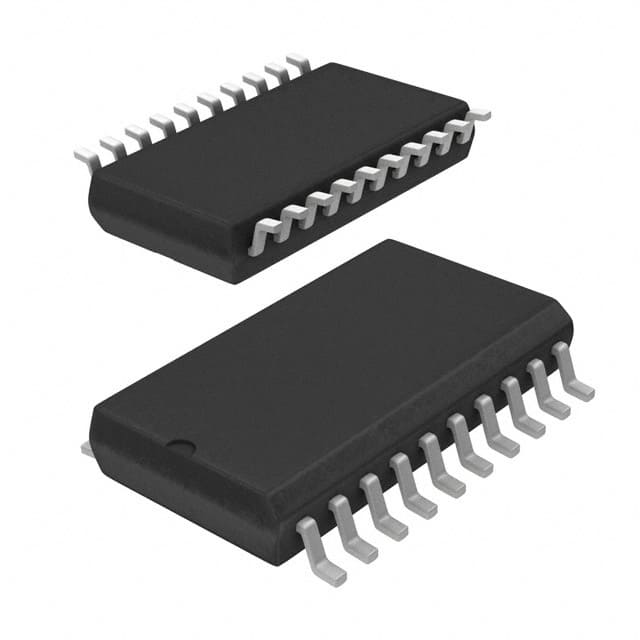SN74ALVC244DWG4
Product Overview
Category: Integrated Circuit (IC)
Use: The SN74ALVC244DWG4 is a high-performance octal buffer and line driver designed for low-voltage (2.5V to 3.6V) applications. It is commonly used in digital systems where voltage level translation is required.
Characteristics: - High-speed operation - Low power consumption - Wide operating voltage range - Schmitt-trigger inputs for noise immunity - 3-state outputs for bus-oriented applications
Package: SOIC (Small Outline Integrated Circuit)
Essence: The SN74ALVC244DWG4 is an essential component in electronic devices that require signal buffering and level shifting capabilities.
Packaging/Quantity: The SN74ALVC244DWG4 is typically sold in reels, with each reel containing 2500 units.
Specifications
- Supply Voltage Range: 2.5V to 3.6V
- Input Voltage Range: 0V to VCC
- Output Voltage Range: 0V to VCC
- Operating Temperature Range: -40°C to +85°C
- Propagation Delay Time: 2.8ns (typical)
- Output Drive Capability: ±24mA
Detailed Pin Configuration
The SN74ALVC244DWG4 has a total of 20 pins, which are assigned as follows:
- A1
- Y1
- A2
- Y2
- A3
- Y3
- A4
- Y4
- GND
- Y5
- A5
- Y6
- A6
- Y7
- A7
- Y8
- VCC
- OE#
- GND
- OE#
Functional Features
- Octal buffer and line driver with 3-state outputs
- Non-inverting outputs
- Schmitt-trigger inputs for improved noise immunity
- High-speed operation suitable for bus-oriented applications
- Low power consumption for energy-efficient designs
Advantages and Disadvantages
Advantages: - Wide operating voltage range allows compatibility with various systems - High-speed operation enables efficient data transmission - Schmitt-trigger inputs provide robustness against noise - 3-state outputs facilitate bus sharing in multi-device systems
Disadvantages: - Limited output drive capability may not be suitable for high-current applications - Requires external pull-up resistors for proper operation in some cases
Working Principles
The SN74ALVC244DWG4 operates by receiving input signals on the A1-A7 pins and providing corresponding buffered outputs on the Y1-Y8 pins. The OE# pins control the output enable function, allowing the device to be put into a high-impedance state when not actively driving the bus.
Detailed Application Field Plans
The SN74ALVC244DWG4 is widely used in various digital systems, including but not limited to: - Microprocessors and microcontrollers - Memory interfaces - Data communication systems - Industrial automation equipment - Automotive electronics
Detailed and Complete Alternative Models
Some alternative models that offer similar functionality to the SN74ALVC244DWG4 include: - SN74LVC244A - MC74LVX244 - 74LCX244
These alternatives can be considered based on specific application requirements and availability.
Word count: 407 words
Lista 10 Vanliga frågor och svar relaterade till tillämpningen av SN74ALVC244DWG4 i tekniska lösningar
Sure! Here are 10 common questions and answers related to the application of SN74ALVC244DWG4:
Q: What is SN74ALVC244DWG4? A: SN74ALVC244DWG4 is a type of integrated circuit (IC) that serves as a buffer or line driver. It can be used to amplify or buffer digital signals.
Q: What is the purpose of using SN74ALVC244DWG4 in a technical solution? A: SN74ALVC244DWG4 is commonly used to interface between different logic families, such as translating signals from a 3.3V system to a 5V system or vice versa.
Q: What voltage levels does SN74ALVC244DWG4 support? A: SN74ALVC244DWG4 supports both 3.3V and 5V voltage levels, making it versatile for various applications.
Q: How many channels does SN74ALVC244DWG4 have? A: SN74ALVC244DWG4 has 8 channels, meaning it can handle up to 8 separate input/output lines.
Q: Can SN74ALVC244DWG4 be used bidirectionally? A: Yes, SN74ALVC244DWG4 supports bidirectional operation, allowing data to flow in both directions.
Q: What is the maximum operating frequency of SN74ALVC244DWG4? A: The maximum operating frequency of SN74ALVC244DWG4 is typically around 200 MHz, but it may vary depending on the specific conditions and setup.
Q: Does SN74ALVC244DWG4 have any built-in protection features? A: Yes, SN74ALVC244DWG4 has built-in ESD (electrostatic discharge) protection, which helps safeguard the IC from damage due to static electricity.
Q: Can SN74ALVC244DWG4 be used in automotive applications? A: Yes, SN74ALVC244DWG4 is qualified for automotive applications and meets the necessary standards and requirements.
Q: What is the power supply voltage range for SN74ALVC244DWG4? A: The power supply voltage range for SN74ALVC244DWG4 is typically between 1.65V and 3.6V.
Q: Are there any specific layout considerations when using SN74ALVC244DWG4? A: Yes, it is recommended to follow the manufacturer's guidelines for proper PCB layout, including minimizing trace lengths and providing adequate decoupling capacitors near the IC.
Please note that these answers are general and may vary depending on the specific application and requirements. It is always advisable to refer to the datasheet and consult with technical experts for accurate information.


